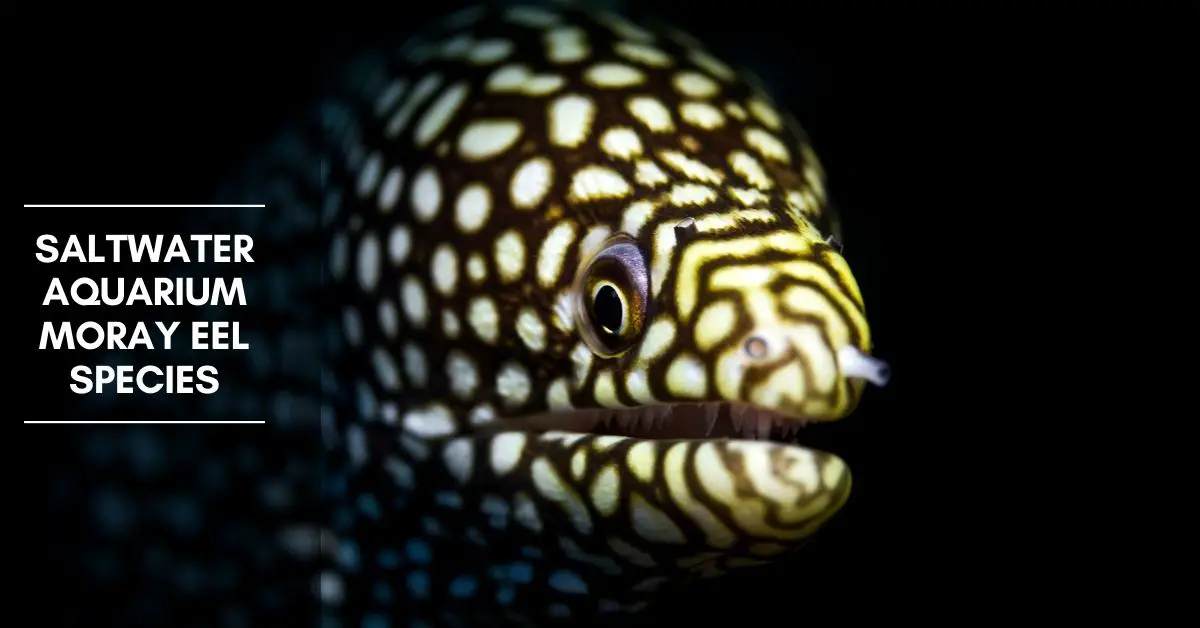While there are nearly 200 species and subspecies of morays worldwide, only a scant few make it to the pet trade. Listed here are some of the most popular and most well understood of the morays you are likely to encounter, and also their habitat, diet, and minimum tank size.
Types of Moray Eels for Aquariums
Snowflake Moray
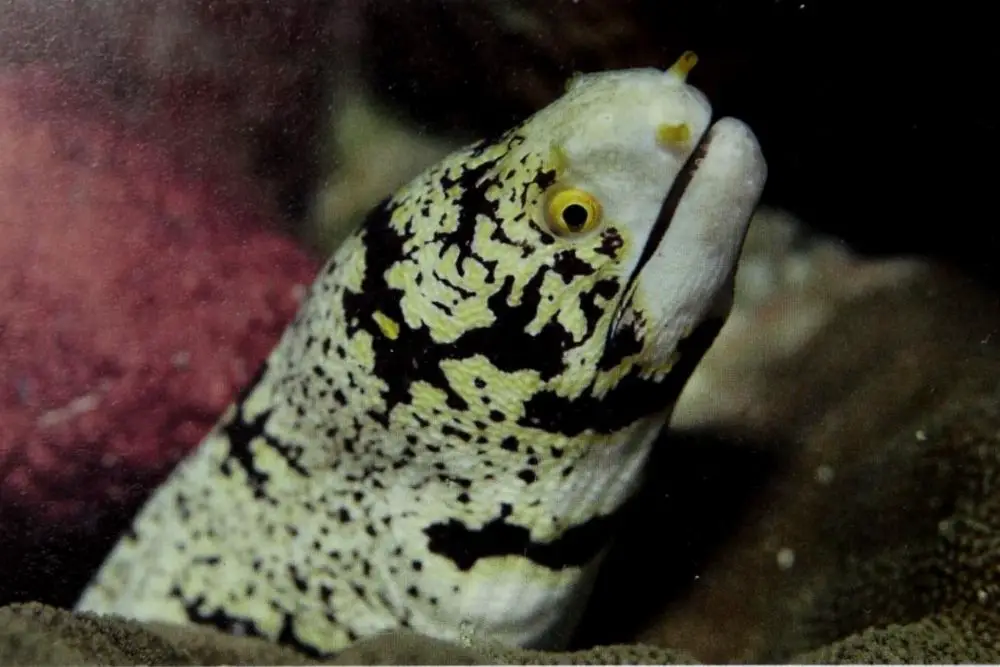
Minimum Tank Size: 55 gallons.
Range: Found throughout the warm shallows of the Indo-pacific region, Red Sea and Eastern Africa to the Society Islands and north through the Sea of Japan, cast to Hawaii, Baja California, and Costa Rica south along the coast Of Columbia.
Size: 12 to 24 inches is common, over 36 inches is rare.
Natural Habitat: A shallow-water species, the Snowflake Eel frequents rocky outcroppings and coral reefs. Seldom living at depths below 100 feet, the Snowflake is also found amid intertidal reef flats, bays, lagoons, and throughout offshore reefs.
Diet & Feeding: Natural diet consists of a wide variety of crustaceans, mollusks, and small fishes. The captive diet should be as varied as possible with vitamin supplements accompanying every second to third feeding.
Favored items include: live or cut shrimps, squid, cockle, mussel, and cut fish. One of the gentler morays, the Snowflake is renowned for taming and taking food directly from the keeper’s hands. This is a calculated risk, though the danger level is not critically high. I do not nor do I recommend the hand feeding of any species of moray.
Description: A slender eel, the Snowflake sports a low dorsal fin and rounded stature. The head is short with a blunt, rounded, and is accented with short nasal protuberances. The basecoat is alabaster white blotched in black to chocolate brown “snowflakes” that form loose bands or rings encircling the body.
Bands may be interspersed with an underlying yellow tint, especially around the head and neck. Space between the Snowflakes is irregularly peppered in black to brown specks. Chin and nose are solid white. Eyes and nasal tubercles are bright yellows. Highly nocturnal.
Special Conditions: A master escape artist, the Snowflake Moray will likely find and slither through even the tiniest gaps in the lid of its tank. Because of its small stature, it can fit through holes that other species cannot. Adding a Snowflake Eel (or any other slender moray, for that matter) requires a serious re-evaluation of tank security.
Barred Moray
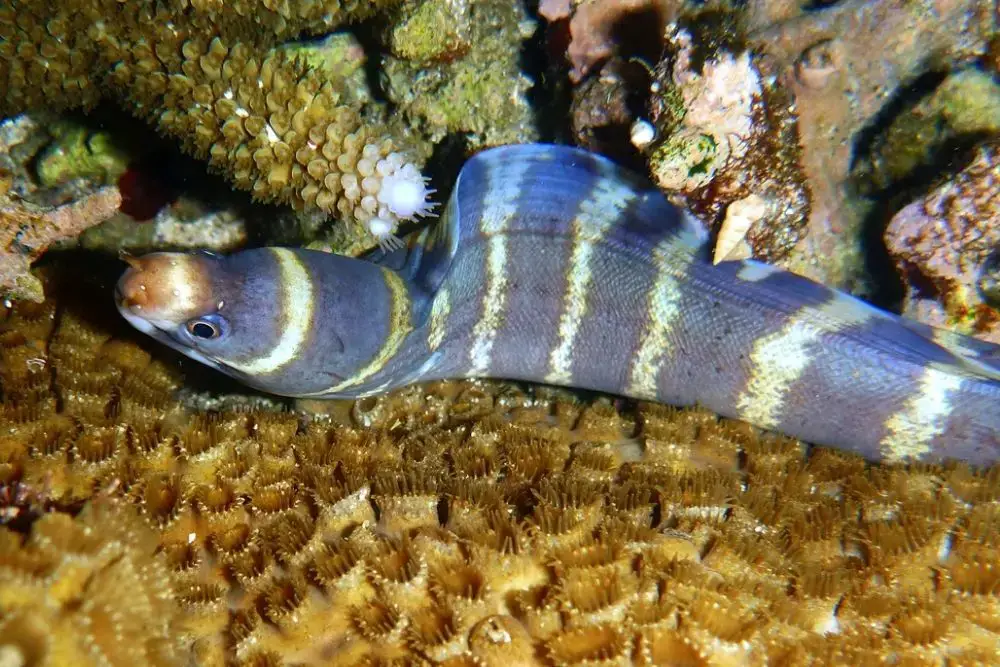
Minimum Tank Size: 75 gallons.
Range: From the Red Sea and eastern Africa east to Hawaii. Also found at Ryukyu Islands and south to the Great Barrier Reef and throughout Micronesia.
Size: Large adults may near 30 inches, though 22 to 25 inches is average.
Natural Habitat: Reef flats, shallows lagoons, intertidal pools, and other areas of very clear, sheltered waters. Seldom ventures more than 30 to 40 feet down.
Diet & Feeding: Like most of its Echidna brethren, the Barred Moray is adept at feeding on crustaceans. Venturing out from its retreat, this animal will patrol the nooks and crannies of the reef in search of shrimps, crabs, octopuses, and recently molted lobsters. The Barred Moray is primarily nocturnal, though it may be active at all points of the clock.
Description: Wearing a base color of pale to charcoal gray or black with vertical bars of white to ivory or cream, the Barred Moray looks strikingly similar to its close cousin, the Zebra Moray, though the former’s white bars are much wider. Head and lower jaw may be yellowish.
The snout is short and rounded, and the teeth are peg-like and come to blunt points. When powered by this moray’s strapping jaw musculature, these teeth are perfectly suited crushing through the brittle exoskeletons of the moray’s crustacean prey. The tail tapers noticeably to a distinct point, and the dorsal fin is low.
Special Conditions: Barred Morays enjoy (and require) their caves and hideaways, but may move about the tank considerably more so than other (Echidna) morays. They must, therefore, be housed with tankmates that will not pester or stress them during the course of their daily roving.
These animals do especially well when housed alone in a reef tank, though they can thrive with larger, benevolent fish species such as Lions or small groupers. Avoid mixing with fast-moving or nippy species such as wrasses, tangs, angels, dwarf angels, and triggers.
Dragon Moray
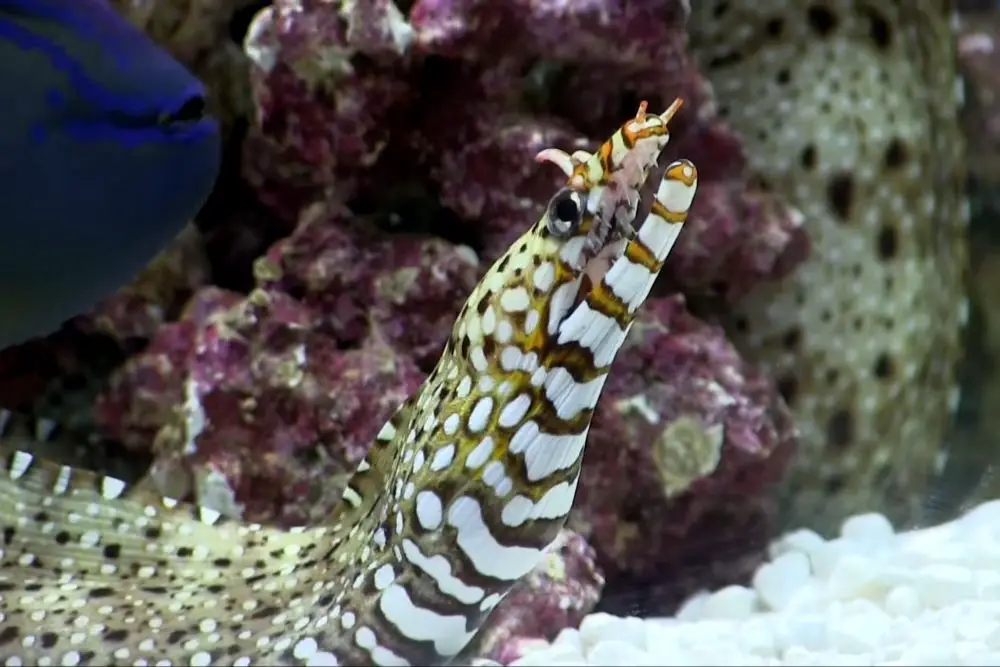
Minimum Tank Size: 125 gallons.
Range: Indo-pacific. Hawaii to the Society Islands, north through the Sea of Japan and South Korea, south through northern Australia and New Caledonia.
Size: Captive specimens seldom exceed 30 to 33 inches, while wild individuals may reach 36 inches. Unconfirmed reports of 40-inch animals or longer are questionable.
Natural Habitat: Another dweller of the shallows, the Dragon Moray seldom ventures more than 150 feet down, as it is intolerant of deeper, colder waters. Frequents the living reef and its network of tight caves, overhangs, sunken wreckage, intertidal zones, and rocky coastlines.
Diet & Feeding: A devout piscivore, the Dragon Moray thrives on fish, though recently molted or delicate crustaceans are taken when the opportunity arises. Squid and octopus are particularly relished, and the ferocity with which a Dragon Moray will subdue these mollusks is not for the faint-hearted.
Description: A stunningly gorgeous eel, the Dragon Moray is an absolute kaleidoscope of color. Although exact coloration varies greatly from one individual to the next, the base is typically brown to light cream or golden with white to yellow or golden spots and irregular blotches adorning the
face and body, with vertical bars or contiguous blotches on the dorsal fin.
Blotches may be outlined in gold. The exaggerated curvature of the snout and pronounced teeth identify this species as highly adapted to hunting fish; the jaws and teeth function to pierce the scales, not of sleeping fare, but of active, struggling prey.
Nares are exaggeratedly pronounced. Posterior nostrils accented by extremely long tubercles, which are situated directly over the eyes, giving the animal a distinct appearance.
Special Conditions: The top causes of Dragon Moray mortality in captivity are poor water conditions and stress. Utilize superior filtration and protein skimming, and provide excessive shelter for your eel. During the acclimation process, this moray may spend 100 percent of its time hidden within the rockwork of the tank. Don’t disturb it!
API STRESS COAT Aquarium Water Conditioner 16-Ounce Bottle
Tetra AquaSafe Plus, 8.45 Ounces, aquarium Water Conditioner And Dechlorinator, Model Number: 46798162681
$10.19 (as of December 2, 2025 04:09 GMT +03:00 - More infoProduct prices and availability are accurate as of the date/time indicated and are subject to change. Any price and availability information displayed on [relevant Amazon Site(s), as applicable] at the time of purchase will apply to the purchase of this product.)API TAP WATER CONDITIONER Aquarium Water Conditioner 16-Ounce Bottle
$8.48 (as of December 2, 2025 04:09 GMT +03:00 - More infoProduct prices and availability are accurate as of the date/time indicated and are subject to change. Any price and availability information displayed on [relevant Amazon Site(s), as applicable] at the time of purchase will apply to the purchase of this product.)This period of hiding is critical to its stress and health level, and as soon as it grows accustomed to the sights and smells of its new home, your Dragon Moray will emerge on its own. It does better in a quiet reef tank than in a fish-only tank, as the organic wastes produced by fishes can be problematic.
Zebra Moray
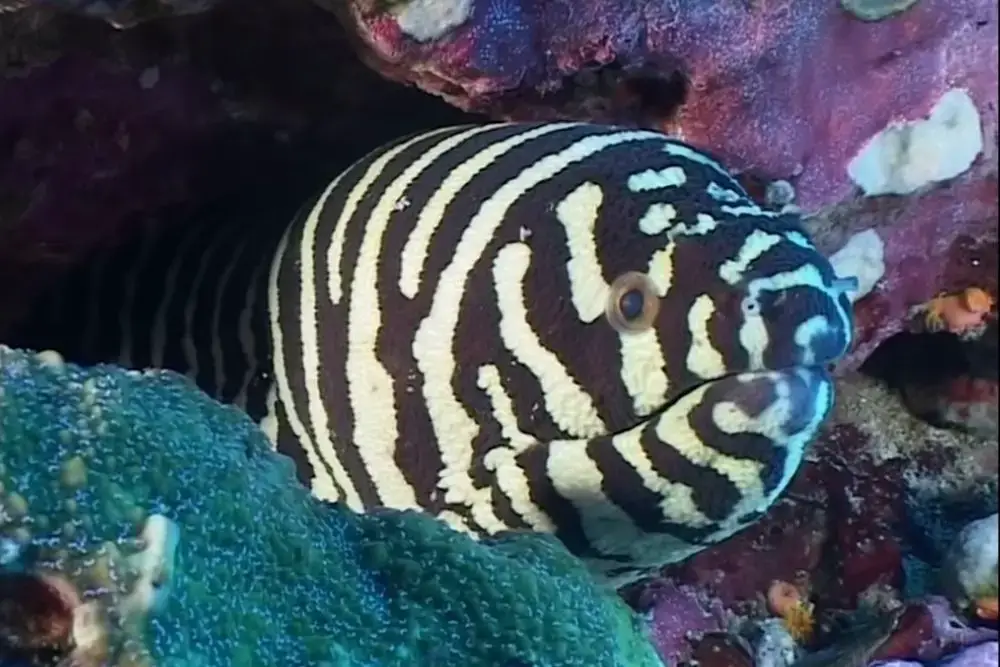
Minimum Tank Size: 75 gallons.
Range: Indo-Pacific. Found from the Red Sea and eastern coast of Africa, east to Hawaii and Ryukyu, south through the Great Barrier Reef.
Size: Average adult size is 30 to 36 inches, I have personally seen one specimen measuring 58 inches, and have heard of individuals even longer than that, though Zebras of such proportions are exceedingly rare in captivity.
Natural Habitat: Another lover of the shallows, the Zebra Moray is a reef-centric species that seldom ventures far from to safety of the coral caverns and reef overhangs. Any dark, hidden retreat within its range is liable to house a Zebra Moray.
Diet & Feeding: With short, pebble-like teeth and powerful, stocky jaws, the Zebra can crack through the hard shells of its favorite foods: crabs, mollusks, snails, clams and other bivalves, and sea urchins. This moray is a slow-moving hunter and mostly forages along the seafloor in search of shelled quarry. Seldom eats fish.
Description: True to its common name, the Zebra Moray sports a stunning coat of gray to black or purple to maroon striped with solid or broken vertical bars of white to cream or yellow. Head is short with a blunt snout and reddish eyes. Nares are highly reduced in this species, though its sense of smell is quite acute. A heavy-bodied eel, the Zebra Moray has a rounded frame, typical of the slower moving species.
Special Conditions: Not a reef-safe animal. Only corals and anemones will thrive in the company of a Zebra Moray. All crustaceans, mollusks, bivalves, and echinoderms are potential prey items. In the fish-only tank, provide this eel with at least four inches of substrata and plenty of structure for security. Use caution when mixing with fish.
While docile by nature, this moray may become mildly aggressive or nippy when is present. The Zebra Moray is also prone to periods of aestivation, and may not eat or show itself for several weeks. This is no cause for alarm.
Abbott’s Moray
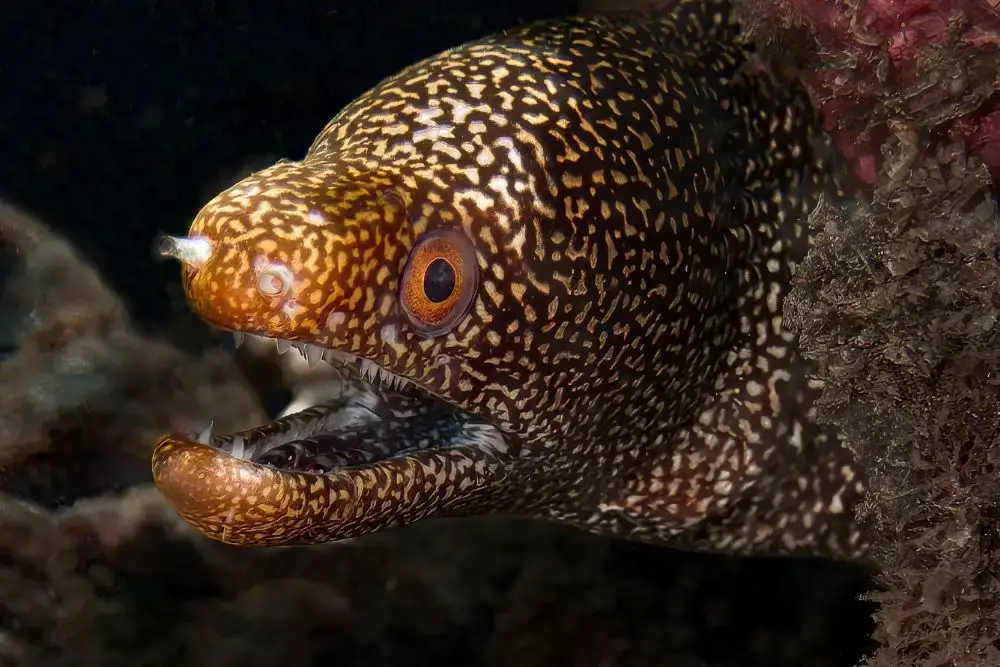
Minimum Tank Size: 75 gallons.
Range: Indo-Pacific. Reported from Seychelles to Costa Rica, Panama, and Easter Island.
Size: May exceed 30 inches, though captive specimens normally max out at 24 inches.
Natural Habitat: A strictly nocturnal species, the Abbott’s Moray takes refuge from daylight in inshore reefs, sunken ship wreckage, undersea caverns, and other sheltered, yet shallow areas. Large individuals may live in surprisingly small crevasses within the reef.
Diet & Feeding: An indiscriminate carnivore, the Abbott’s Moray preys upon the small and unwary things on the reef: fiddler crabs, shrimps, small or freshly molted lobsters, squids, octopuses, and any fish small enough (and slow enough) to be eaten.
The animal’s reclusive nature suggests it feeds primarily on crawling things and sluggish organisms of the reef, as it is not a particularly fast predator, nor does it often expose itself by hunting in open waters.
Description: A truly beautiful creature, the Abbott’s Moray ranges from a regal purple to light brownish coloration, and is freckled in tiny golden to yellow-brown spots. Head is densely speckled, the tail is only faintly peppered. The snout is slightly elongate but ends abruptly in a squared-off chin.
Eyes and nares closely set together, and the cleft of the mouth extends to behind the eye. Moderate dentition, vomerine present, but not nearly the same caliber as that of larger Gymnothorax species.
Special Conditions: The Abbott’s Moray needs perhaps more rockwork and more retreats than any other species of Moray. If it does not feel secure within its aquascape, it will likely refuse food for extended periods of time, stressing and possibly starving itself to death.
Supply numerous caves and hideaways, and house alone or in the company of extremely docile fish species.
Blackspotted Moray
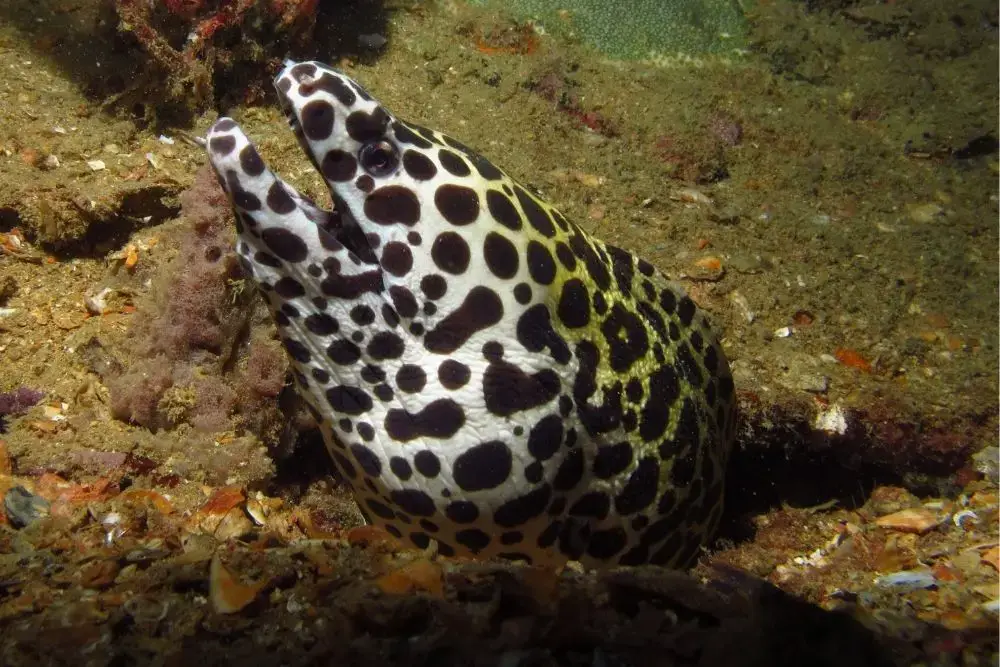
Minimum Tank Size: Over 200 gallons.
Range: Throughout the Indian Ocean and Indo-Pacific. Red Sea east to the Philippines and south through the Great Barrier Reef and surrounding Papua New Guinea. Northern range extends into the Sea of Japan.
Size: A true titan among the morays, this hefty species may reach lengths of up to 10 feet, and may weigh over fifty pounds.
Natural Habitat: A top predator of the reef environment, this eel is found wherever food abounds. Often encountered by divers along the reef and in the port windows of sunken ships, the Blackspotted Moray also frequents sheltered bays, lagoons, rocky shallows, intertidal flats, cavernous overhangs, and the root entanglements of brackish estuaries and river deltas.
Diet & Feeding: An accomplished hunter, the Blackspotted Moray moves about under the cloak of night, foraging for sleeping fish, all manner of crustaceans, and especially cephalopods, which may comprise more than 60 percent of its diet in the wild.
Description: One of the most attractive of all morays, the Blackspotted Moray sports a base color of white to yellowish, but is covered in thousands of irregular brown to black spots.
Seldom overlapping, these spots are situated tightly enough to form a honeycomb or chain-link pattern over the entire body, a quality that has earned this eel the alternate moniker “Honeycomb Moray” (not to be confused with the true Honeycomb Moray (Muraena Melanotis) of the Atlantic Ocean).
The Blackspotted Moray has perhaps the sharpest and most pronounced dentition of all morays: a double row of razor teeth lining the upper jaw, a single row on the lower, and a palate of long, sharp vomerine teeth.
Special Conditions: Like the Green and Giant Morays, this species lives in mutualism with cleaner wrasses and shrimps. House in the company of a White-Banded Cleaner Shrimp, Scarlet Cleaner Shrimp, or a Cleaner Wrasse. Shrimps are preferred for this purpose, as a hungry Blackspotted Moray will not hesitate to devour its symbiotic wrasse.
Fimbriated Moray
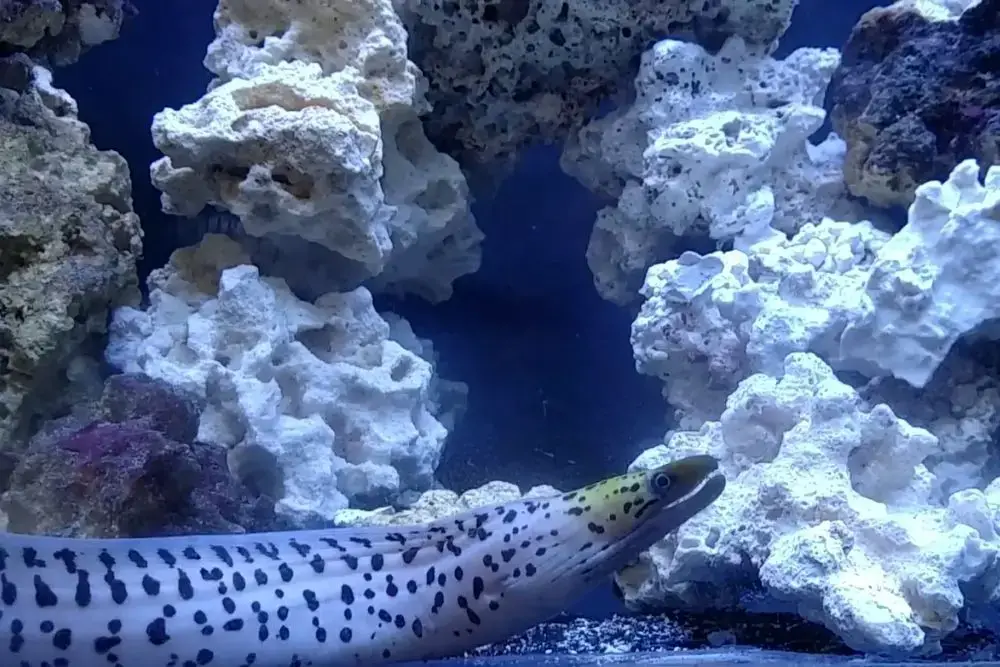
Minimum Tank Size: 75 gallons.
Range: Ubiquitous in the Indo-Pacific. From Madagascar and eastern coast of Africa, east to the Society Islands, south to Queensland, and north through the Sea of Japan.
Size: One of the smaller of the Gymnothorax morays, the Fimbriated seldom reaches lengths greater than 30 to 32 inches.
Natural Habitat: Typically reef-associated. Marine environments include coral reefs, shipwrecks, tidal flats, seaward ledges, and reef overhangs, mangrove tangles, rocky outcroppings, grassy sandbars, and sheltered areas. Also thrives in brackish deltas, inshore estuaries, and harbors.
Diet & Feeding: Small fishes and all variety of bite-sized crustaceans.
Description: An attractive, spotted species, the Fimbriated Moray wears a basecoat of light tan, to greenish-yellow, and is accented with darker spots scattered randomly over the body. Some specimens have heavier or lighter speckling than others or heavier mottling in one spot. Some spots overrlap, making for a blotching effect.
Spots are largest on young morays and tend to diminish in size and frequency with age. The Fimbriated Moray favors tight hideaways and spends much of its day with only its head exposed. Primarily nocturnal. Like all Gymnothorax species, the Fimbriated comes equipped with elongate, arching jaws, and impressively sharp teeth.
Special Conditions: Fimbriated Morays tend to be picky eaters in captivity, and may stop feeding abruptly and seemingly for no reason. To combat this, lessen the duration of any lighted period the tank currently experiences; no more than 8 to 10 hours of light each day.
Offering a variety of foods (squid, octopus tentacles, silversides, etc.) may also prompt your Fimbriated into resuming its former eating habits. Lastly, soak the food in a marine multivitamin supplement, as proper vitamins tend to raise the animal’s metabolism and stimulate a healthy appetite.
Moray eel tank
Not just any aquarium is suitable to house a moray. These fish are masters of escape, haters of sunlight, devourers of tankmates, and topplers of unstable rocks, so there are a few considerations that must be made before adding a moray into your aquarium.
If you already have an established, mature marine tank and your wish to house an eel in it, then likely you’ll have to make some modifications to accommodate your new pet, but the workload will not be too intense.
If, however, you are on the path I was so many years ago and are just starting up a tank because you saw a moray in the pet shop and now wish to do whatever it takes to own one, then you’ve got your work cut out for you.
On the plus side, your moray will have its own home that was custom built just for it from the ground up, so chances are both you and your moray will be exceedingly satisfied with the results.
Tank Size
Imagine you are walking down the street and you see a lady walking a Labrador Retriever. Around the dog’s neck is a collar that is five sizes too small, and strapped around its back is a harness that is equally tiny.
The dog hassles and struggles to breathe against the choking collar, and his fur is irritatingly raised around the edges of the nearly lacerating harness. “Hi,” the lady says happily. “Like my dog? I got him just last month and I love him to death!” You look at the lady and marvel at how cruel and ignorant she must be to shackle her beloved pet in such painfully tight constraints. Someone needs to tell her how to properly collar and harness her poor dog!
The same holds true for moray eels, but far too many hobbyists keep them in frightfully small enclosures. Though we may not pet them, or scratch them behind the gills, or roll playfully in the grass with our morays, they still don’t deserve to be constrained in tiny quarters.
Let’s face it, morays are big creatures, and they need equally big tanks to call home if they are to thrive under our care. But when I say “big tanks,” I do not necessarily mean big in terms of absolute volume, for even though a very tall, thin, octagonal tank may hold 300 gallons and thus be considered a “big tank,” it still may not grant a 24-inch long Snowflake Moray the room to stretch out.
The prevailing dimensions are length and width, with height being the least of your concerns. This concept is actually true with many, many other species of both freshwater and marine fishes. Morays are, regardless of species, primarily bottom dwellers, so depth of the tank is of little concern in their daily lives.
A tank should be at least two times as long as the moray’s total body length, and as wide as possible. This will allow the moray plenty of horizontal swimming space and room to fully straighten and extend its elongate body.
Morays that are not able to fully stretch out suffer undue stress, and normally do not live longer than a few years in captivity, even when all other tank conditions are perfect. Your best bet, in terms of long-term success with your eel, is to determine which species of moray you wish to keep before purchasing the tank.
Figure out that species’ maximum adult length, and purchase a tank that can comfortably accommodate the animal throughout its entire life span. Tank volume is, however, important in terms of stable water quality.
One good bowel movement on the part of a Purple Mouth or Zebra Moray will produce a certain amount of waste, which we will call “X.” Now I was never good at math, but this equation is really a no-brainer. X in a 20-gallon tank will be ten times the concentration compared to the same volume of waste in a 200-gallon tank.
Therefore, larger tanks not only afford your moray room to swim and move, but also allow biological wastes more room to dissipate within the water column. So even though your eel may be a small one, remember that the larger its tank is, the less frequently you must conduct water changes although you still must do water changes.
The healthier and more ecologically balanced your tank is, the infinitely easier your moray husbandry will be in terms of work, expense, and pet longevity. Small quarters also increase outbreaks of violence in the community tank.
A moray with plenty of room to call its own might live for decades in harmony with its tankmates, while a moray of the same species that feel cramped or restricted in its tank is likely to lash out against anything that draws near.
Not only are tankmates at a higher risk of fighting, but escape attempts will rise, as will potential bites to the keeper during routine maintenance, water changes, or feedings.
Summary
Having conquered virtually every body of tropical and temperate saltwater on the planet, most moray eels are reef-associated, seldom thriving above or below the range of the reef.
Other morays are demersal, meaning they can thrive in a range of depths and may be found in tidal pools or several feet below the surface. Still, others are totally benthic, living only at very great depths.
Some moray species, such as the Freshwater Moray and Unicolor Snake Moray have even mastered lite in brackish estuaries and in freshwater river deltas.
Most morays are reclusive creatures that seldom seek the company of other eels. They are hermitic predators spending their days in hiding and enjoy the predictability of the reef around them. Some species stray about the reef continually to find food.
but most return to their hole after foraging. As a general rule, a moray’s hole is its home, and with the idea of home comes territoriality. And undersea creatures will defend their territory with as much vehemence as the moray eels.
Of course, the degree of territoriality depends on both the species, as well as the individual in question. I have seen male morays battle to the death over a preferred hideaway, but I have also witnessed pairs, trios, or even more of the same species thrive communally in a single cavern.
Much like people, each moray eel comes equipped with a distinct “personality,” and much like our species, there is no concrete way to predict how an entire species will behave based on the actions of a few individuals.

Hi, my name is Sean, and I’m the primary writer on the site. I’m blogging mostly about freshwater and saltwater aquariums, fish, invertebrates, and plants. I’m experienced in the fishkeeping hobby for many years. Over the years I have kept many tanks, and have recently begun getting more serious in wanting to become a professional aquarist. All my knowledge comes from experience and reading forums and a lot of informative sites. In pursuit of becoming a professional, I also want to inspire as many people as I can to pick up this hobby and keep the public interest growing.
Read more about Sean.
Please join also my Facebook group.

